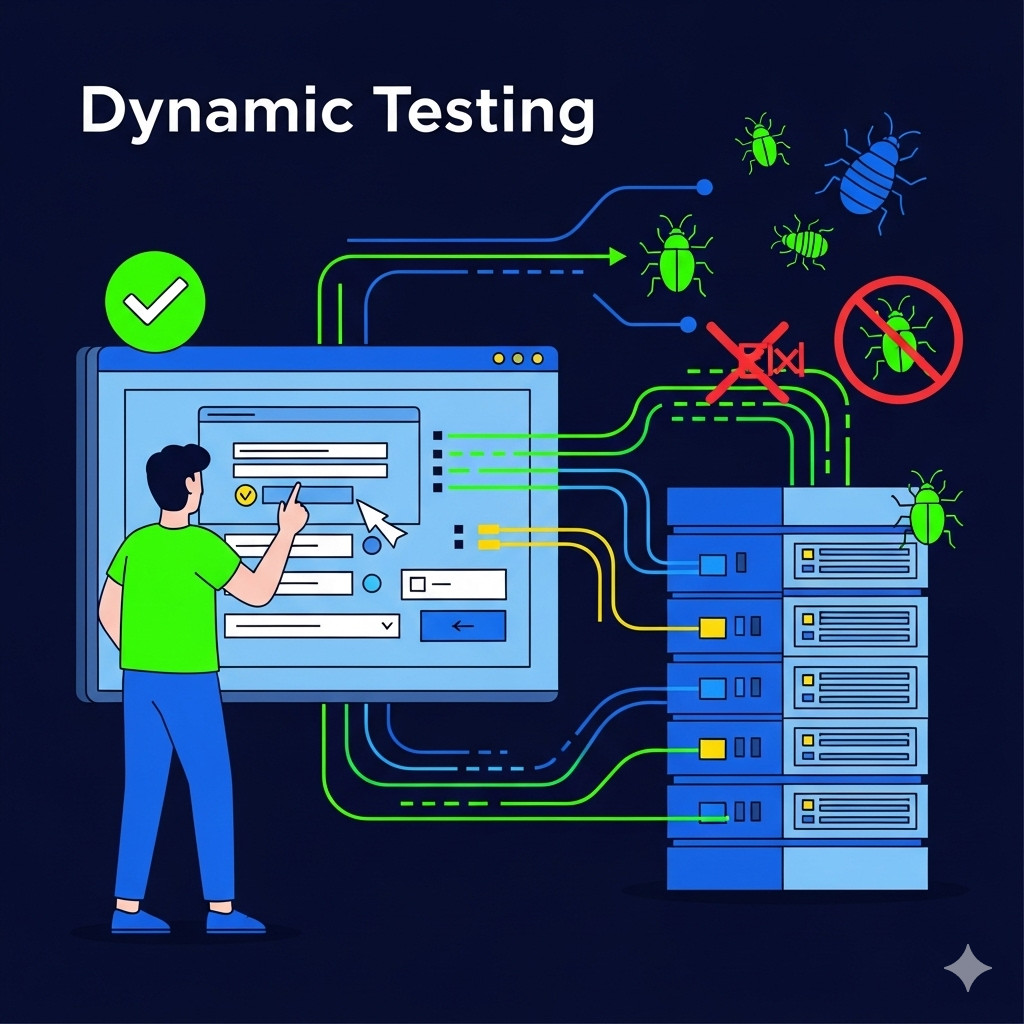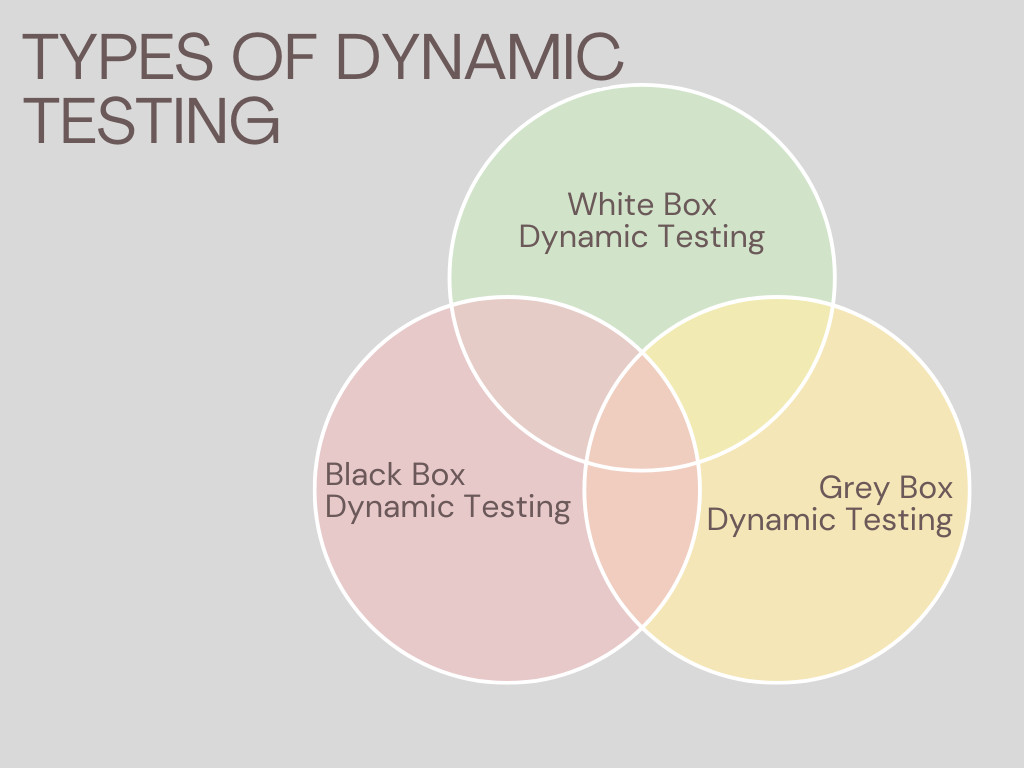What is Dynamic Testing? A Complete Guide
|
|
Dynamic testing is a critical stage of the software testing process that entails the execution of a software program or application to test its behaviour and to ensure that it satisfies the requirements.
In contrast to static testing, which is concerned with the review of the code, documents, and other project artifacts without executing the software, dynamic testing assesses both the functional and non-functional features of the application by executing it in an environment that resembles real-world conditions.

Dynamic testing is very important in detecting problems associated with system functionality, performance, and security prior to the product being delivered to the end-user. Also, dynamic testing may be conducted manually and automatically, which provides flexibility based on the complexity and scope of the software under test. The importance of dynamic testing cannot be overestimated, and it has a direct impact on the overall quality of the software, user experience, and security.
| Key Takeaways: |
|---|
|
What is Dynamic Testing?
Dynamic testing entails the running of a software application to test its behaviour and functionality under certain conditions. In contrast to static testing, which analyzes the code and documentation of the software without executing the program, dynamic testing is interested in the validation of the performance of the software in action.
Dynamic testing helps to detect defects, bugs, and problems that cannot be detected by using only static analysis. In dynamic testing, the software is actively executed in a controlled environment, where different inputs, user interactions, and system conditions are simulated to monitor the system response. This is done to make sure that the software will act as intended and fulfill the requirements in the real-world application. In simple terms, dynamic testing is required to make sure that the software is not only functional but also resilient, secure, and efficient when applied in the real world.
Objectives of Dynamic Testing

- Check Functional Behaviour: The main goal of dynamic testing is to ensure that the software is functioning as per its functional specifications. This involves ensuring that features perform as desired in different conditions and that the system is performing as per the requirements.
- Identify Defects and Bugs: Dynamic testing is used to identify bugs, performance problems, or security vulnerabilities that may adversely affect the user experience or system functionality. Dynamic testing is used to detect defects that are not apparent in the static code analysis by executing the software in a test environment. Learn about different types of defects: Types of Defects in Software Testing.
- Validate Performance and Efficiency: This kind of testing is used to verify that the system is efficient in both normal and peak load conditions. It assists in determining bottlenecks, resource limitations, or performance problems like slow processing time, memory leakage, and high CPU utilization.
- Ensure Integration and Interaction: Dynamic testing checks the interaction of various parts of the software with one another, and makes sure that the system is functioning as an integrated whole. This involves testing the inter-module communication, database communication and external system interfaces.
- Test Usability: The user interface and experience of the software can also be tested dynamically to verify the ease of use and functionality of the software with various types of users and devices.
Key Characteristics of Dynamic Testing
Dynamic testing allows software to be tested during runtime, thereby guaranteeing that the program runs correctly in the real world. To better understand its importance, let’s look at the key characteristics that define dynamic testing and highlight how it differs from static approaches.
- Execution-Based: Dynamic testing involves the real execution of the software application. In contrast to static testing, which is performed by examining the code, documentation, or models, dynamic testing is based on live interaction with the software in its running state.
- Real-Time Evaluation: Dynamic testing is used to test the behaviour of the system in real-time by inputting different inputs into the software and monitoring the output. This real-time testing enables testers to monitor the system response to various stimuli, such as user actions, environmental variations, and system resources.
- Pay Attention to Functional and Non-Functional: Dynamic testing encompasses both functional and non-functional testing of the application. Functional testing is used to verify that the features and capabilities of the software are functioning as intended, whereas non-functional testing is used to test aspects such as performance, security, scalability, and usability.
- Error Detection During Execution: Dynamic testing is one of the main objectives that aim at identifying defects and errors in the execution of the software. Bugs, memory leaks, crashes, and other unexpected behaviours are usually detected during runtime, and this would not be achievable with only the help of the static analysis.
- Test Coverage: Dynamic testing usually involves extensive test coverage, such as testing various paths, branches, and user scenarios to make sure that the software works properly under all possible execution conditions. Read more: Code Coverage vs. Test Coverage.
- Feedback-Driven: Dynamic testing is feedback-driven and iterative. The results of the tests are used to direct the testing process, and testers keep on refining the test cases and scenarios depending on the past observations.
Static vs. Dynamic Testing
Both static and dynamic techniques play complementary roles in ensuring product quality. Static testing focuses on reviewing code, documents, or design artifacts without executing the software, making it effective for early defect detection. Dynamic testing, on the other hand, requires the actual execution of the application to evaluate its behavior under different conditions. Comparing these two approaches highlights their unique strengths and shows why both are essential for building reliable software.
| Aspect | Static Testing | Dynamic Testing |
|---|---|---|
| Definition | Involves reviewing and analysing code, documentation, and other project artifacts without execution. | Involves executing the software and testing its behaviour under real-world conditions. |
| Execution | No execution of the program. | Requires the execution of the program. |
| Timing in SDLC | Performed early in the development process. | Performed after coding, during, or after development. |
| Focus | Focuses on syntax, code structure, and document consistency. | Focuses on verifying functional behaviour, performance, and security during execution. |
| Error Detection | Detects syntax errors, logical flaws, and deviations from standards. | Detects runtime errors, performance bottlenecks, and issues related to system behaviour. |
| Tools Used | Code review tools, static analysis tools, and inspection techniques. | Test execution tools, performance monitoring tools, and automation tools. |
| Cost and Effort | Less time-consuming and less resource-intensive. | More time-consuming and requires running the software with different inputs. |
| Test Scope | Limited to reviewing code and documents. | Broad, covering different modules, functions, and user scenarios. |
| Testing Type | Manual or automated code review, inspections, and walkthroughs. | Manual or automated execution, functional tests, performance tests. |
Types of Dynamic Testing
Dynamic testing can be broadly classified into three categories. Let’s look into each of them in detail.

White Box Dynamic Testing
White box dynamic testing is the testing of the internal functionality of an application with access to the source code. Testers create tests according to their knowledge of the code structure and logic to make sure that all the code paths, conditions, and branches are tested.
Black Box Dynamic Testing
Black box dynamic testing is concerned with the functionality of the software as seen by the user. The internal code or system architecture is not available to testers. Instead, they develop tests according to functional requirements and inputs, and assess whether the software will act as desired in various circumstances. Black box testing can consume more time when done manually. To make it more effective, automate the test cases using AI-powered test automation tools like testRigor.
With testRigor, manual testers can create automation scripts using the Natural Language Processing (NLP), Gen AI, Vision AI, and AI context. This allows non-technical stakeholders to contribute in testing process by creating or updating test cases. Also, testRigor enables test execution across multiple devices and platforms simultaneously, significantly reducing both time and effort.
Grey Box Dynamic Testing
Grey box dynamic testing is a hybrid of White Box and Black Box testing. Testers possess incomplete information about the internal system components, including architecture, design, or database structure, but not the complete source code. This type of testing is used to detect functional problems as well as taking into account the structure and components of the underlying system, with an emphasis on such aspects as security and data flow.
Understand more: Black-box vs Gray-box vs White-box Testing: A Holistic Look.
Levels of Dynamic Testing
Dynamic testing is applied across multiple stages of the software testing life cycle (STLC):
Unit Testing
The first level of dynamic testing is unit testing, which is the testing of individual units or components of the software, e.g., functions or methods, in isolation. The goal is to make sure every line of code works as intended. Unit testing is usually performed by developers and is aimed at verifying the correctness of a small unit of functionality.
Integration Testing
Integration testing concerns the interactions among various software units or components. It is done after individual units have been tested in isolation to determine whether they can work together. This testing level confirms that data is correctly transferred between modules and that integrated components are working as intended.
System Testing
System testing is the evaluation of the whole software system. It is the process of testing the entire integrated application to verify that it fulfills the requirements and works properly in the target environment. System testing encompasses both functional and non-functional testing, such as performance, security, and usability, and makes sure that the system is functioning as a whole. This is the level of testing that is normally conducted by expert testers.
Acceptance Testing
The last stage of dynamic testing is acceptance testing, which is done to ascertain whether the software is ready to be released and it fulfills the business requirements. The client or end-users usually perform this testing which is aimed at testing whether the software meets the intended use cases.
Dynamic Testing Techniques
Dynamic testing employs numerous techniques depending on objectives:
- Boundary Value Analysis (BVA): Tests inputs at the minimum, maximum, and just inside/outside boundary values, as defects often occur at these edges. It ensures robustness when handling limit conditions.
- Equivalence Partitioning (EP): Groups input data into partitions where one value can represent the entire group. This reduces the number of test cases while still ensuring broad coverage.
- Error Guessing: Leverages tester intuition and experience to predict likely problem areas in the system. It helps uncover defects that structured techniques might miss.
- State Transition Testing: Examines how the system behaves when transitioning between different states based on triggers or inputs. It is especially useful for applications like workflows, ATMs, or login systems.
- Decision Table Testing: Uses tables to represent complex business rules and input combinations with expected outcomes. This ensures all possible conditions and decisions are validated.
- Exploratory Testing: Involves simultaneously learning about the system, designing tests, and executing them. It provides flexibility and adaptability, especially in uncertain or rapidly changing requirements.
- Random Testing (Monkey Testing): Feeds random, unpredictable, or invalid inputs into the system. It helps test the application’s stability and resilience against unexpected user behavior.
Read more: Test Design Techniques: BVA, State Transition, and more.
How Static and Dynamic Testing Work Together
The roles of static and dynamic testing in the software development process are complementary and offer various perspectives and advantages:
- Early Detection vs. Real-Time Behaviour: Static testing assists in detecting possible problems at an early stage of the development cycle through the analysis of code and design documents. It allows developers to identify syntax and structural errors earlier in the SDLC when they are simpler and less costly to resolve. Dynamic testing, by contrast, assists in ensuring that the software is functioning as intended in practice and that runtime problems that cannot be identified by static analysis alone are identified.
- Prevention vs. Detection: Static testing is used to prevent problems by identifying errors in the design or code at an early stage. It is concerned with making sure that the software is structurally sound and follows best practices. Dynamic testing, however, identifies problems in the real execution, so that the software is running properly in real conditions and user interactions.
- Code Quality vs. Functional Quality: Static testing is more focused on the quality of the code itself – whether it is well-written, meets the coding standards, and contains no bugs. Dynamic testing is concerned with the functional quality of the application, which is to ensure that the system works as it is supposed to and that it satisfies the user requirements in the process.
- Cost Efficiency: Static and dynamic testing assist in minimizing long-term costs, albeit in varying ways. Early detection of defects through static testing lowers the cost of correcting bugs in the SDLC. Dynamic testing is used to make sure that the software is functioning as intended, which ultimately lowers the maintenance costs and the chances of post-deployment failures.
Advantages and Challenges of Dynamic Testing
| Advantages | Challenges |
|---|---|
|
|
Conclusion
Dynamic testing is more than just executing code; it is a philosophy of validating software in action. From unit testing to user acceptance, from manual exploratory tests to AI-driven automation, dynamic testing ensures that software not only works but thrives in real-world conditions. By combining structured methodologies, innovative tools, and intelligent automation, dynamic testing provides the confidence to deliver reliable, high-quality software in today’s fast-paced development landscape.
With its AI-powered, plain-English approach to test automation, testRigor makes dynamic testing more efficient, accessible, and scalable for modern teams.
| Achieve More Than 90% Test Automation | |
| Step by Step Walkthroughs and Help | |
| 14 Day Free Trial, Cancel Anytime |












